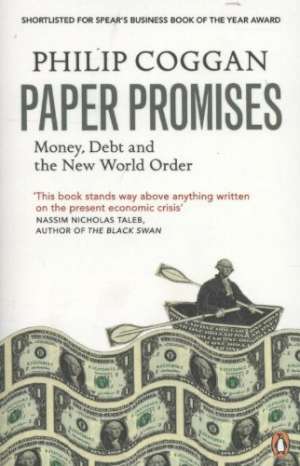01 July 2012
Paper Promises
Money Debt and the New World Order
Philip Coggan
2012, Allen Lane, 304 pages, £20.00
ISBN 9780718192143
Reviewer: John Whitley, Senior Global Economist, Unilever

There has been much written recently on the financial collapse in 2008 and consequences for growth and the stability of the global financial system. So what does this new book add to this already burgeoning collection of facts, views and prophecies? Just some of the other recent books include Losing Control by Stephen King, looking at the balance of power between developing and developed economies as his theme for the changing world order; Crisis Economics by Nouriel Roubini, which covers much of the same material as Coggan but with the theme that financial systems are fragile and prone to collapse; Michael Lewis with The Big Short, taking a more detailed look at recent events through personalities in finance; and Raghuram Rajan with his book Fault Lines, which argues that rational responses by different economic agents occur in a flawed global financial system that encourages taking on risk without allowing for the downsides. Then of course there is the definitive tome of Rogoff and Reinhart (This Time is Different).
Philip Coggan’s thesis is that the world has been more successful at creating claims on wealth than wealth itself, hence paper promises that are unlikely to be met. For me the value in Coggan’s book is in some of the basic insights into money and debt - is housing really wealth, for example. Where it is less convincing is in broad discussions of the future of the world financial system, nor does its conclusion flow seamlessly from the contents.
I found the structure of the book at bit confusing. The initial chapters take the broad topic of what money is and how the notion of interest developed, but cover a broad scope of history in doing this. The subsequent chapters have more of a sequential historical theme as the author takes us through the gold standard and depression of the 1930s, the emergence of the dollar and Bretton Woods, and then into bubbles and policies to deal with them (or not) before moving on to debt with the current crisis. It then ends up with a discussion of options for change in the world system.
What I liked about the book was its clear discussion of when money is wealth and the clarity of its discussion of the present crisis, as well as the chapter on bequeathing debt to future generations, and the role of the baby-boomer generation in distorting the more normal intra-generational distribution of debt and savings, covering how this differs across countries (Germany versus the US). I would like to have seen more on the role of bankruptcy and insolvency rules in reneging on promises to repay, but most of the discussion on this relates to the US Chapter 11 system. Another gap is the divergence between ownership and control - executives can take the risks and share in the upside but shareholders bear the losses if ventures fail. Where the book strays away from the role of money, to talk about energy for example, it also works less well. However, overall, this is a book that is well-written and supported by facts.
